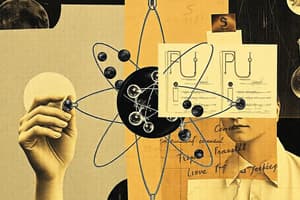Podcast
Questions and Answers
What is one reason Rutherford's model of the atom is considered inadequate?
What is one reason Rutherford's model of the atom is considered inadequate?
- It assumes that energy levels do not exist.
- It states that electrons radiate energy only when stationary.
- It predicts that the atom will collapse due to spiraling electrons. (correct)
- It suggests that electrons do not move around the nucleus.
What type of spectrum is generated when electrons lose energy in a continuous manner according to classical electromagnetic theory?
What type of spectrum is generated when electrons lose energy in a continuous manner according to classical electromagnetic theory?
- Discontinuous spectrum
- Line spectrum
- Quantum spectrum
- Continuous spectrum (correct)
According to Bohr's model, how do electrons revolve around the nucleus?
According to Bohr's model, how do electrons revolve around the nucleus?
- In elliptical paths with varying speeds.
- In random orbits emitting energy.
- In orbits that collapse over time due to energy loss.
- In fixed orbits without radiating energy. (correct)
What happens when an electron jumps from a lower energy level to a higher energy level in an atom?
What happens when an electron jumps from a lower energy level to a higher energy level in an atom?
What is necessary for an electron to remain in a stable energy level according to Bohr's model?
What is necessary for an electron to remain in a stable energy level according to Bohr's model?
Why is the atom considered electrically neutral?
Why is the atom considered electrically neutral?
What is the consequence of an electron moving in accelerated motion around the nucleus in classical theory?
What is the consequence of an electron moving in accelerated motion around the nucleus in classical theory?
In which scenario does an electron generate a photon according to Bohr's model?
In which scenario does an electron generate a photon according to Bohr's model?
What defines the principal quantum number in atomic structure, as per the provided content?
What defines the principal quantum number in atomic structure, as per the provided content?
Which series is produced when an electron in a hydrogen atom moves from high-energy levels to the first energy level?
Which series is produced when an electron in a hydrogen atom moves from high-energy levels to the first energy level?
What is the duration an electron typically remains at a higher energy level before returning to a lower energy level?
What is the duration an electron typically remains at a higher energy level before returning to a lower energy level?
In which region do the frequencies of the Lyman series lie?
In which region do the frequencies of the Lyman series lie?
What happens to an electron in a hydrogen atom when it returns to a low-energy state after being excited?
What happens to an electron in a hydrogen atom when it returns to a low-energy state after being excited?
What is the ground state of a hydrogen atom defined as?
What is the ground state of a hydrogen atom defined as?
Which of the following statements about the energy levels of a hydrogen atom is true?
Which of the following statements about the energy levels of a hydrogen atom is true?
What is the primary characteristic of the Balmer series in relation to energy levels?
What is the primary characteristic of the Balmer series in relation to energy levels?
Study Notes
Rutherford's Atomic Model
- Proposed in 1911, depicted a positive nucleus with electrons orbiting around it.
- Model shortcomings include:
- Electrons in orbit change direction, leading to acceleration.
- Accelerated charges emit electromagnetic radiation, causing energy loss.
- Energy loss results in a spiral trajectory towards the nucleus, predicting atomic collapse.
Limitations of Rutherford's Model
- Continuous energy loss by electrons would generate a continuous spectrum.
- Experimental results show that hydrogen emits a line spectrum, contradicting continuous predictions.
Bohr's Model of the Atom
- Introduced energy levels where electrons revolve in specific allowed orbits without radiating energy.
- Stability of an atom is achieved when:
- Electrons occupy the closest energy levels to the nucleus.
- Atom remains electrically neutral (equal charges of protons and electrons).
Energy Transitions in Atoms
- Electrons can gain energy and jump to higher energy levels, becoming excited.
- When returning to stable levels, electrons emit photons with frequency ( f ), expressed by Planck's equation.
- Planck's constant ( h = 6.63 \times 10^{-34} , \text{J.s} ).
Quantum Mechanics and Angular Momentum
- Angular momentum of an electron in stationary orbits is quantized, given by:
- ( L = mvr = n \times \frac{h}{2\pi} ) (where ( n ) is principal quantum number).
- Total energy levels are negative, indicating electrons do not have sufficient energy to escape the atom.
Hydrogen Atom Spectrum
- Bohr studied hydrogen due to its simplicity (one electron).
- Excited electrons transition back to lower energy levels, emitting specific frequencies.
- The lowest energy level is the ground state (E1); higher levels are excited states (E2, E3, E4, etc.).
Spectral Lines of Hydrogen
- Lyman Series: Transition from high energy to E1 (n=1), produces ultraviolet frequencies (invisible).
- Balmer Series: Transition from high energy to E2 (n=2), produces visible and ultraviolet frequencies.
Studying That Suits You
Use AI to generate personalized quizzes and flashcards to suit your learning preferences.
Description
Explore the key concepts of atomic models, focusing on Rutherford's model and its limitations, and the introduction of Bohr's model. Understand how these models explain the behavior of electrons and energy transitions within atoms. This quiz covers foundational ideas in atomic structure and theory.




